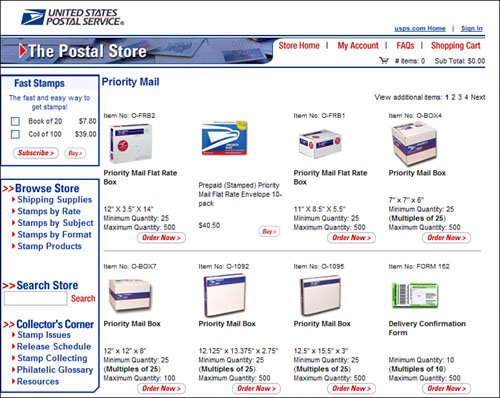Packing 101
| Before you ship, you have to packwhich doesn't sound too terribly difficult. However, if you pick the wrong container, don't cushion the contents properly, don't seal it securely, or mislabel the whole thing, you could risk damaging the contents during shippingor, even worse, sending it to the wrong recipient. Even if you think you know how to pack and ship, you still probably want to read the following sections. You never know; you might pick up a few useful tips! Essential Packing SuppliesBefore you do any packing, you need to have some basic supplies on hand. I'm not just talking boxes here; I'm talking about the stuff you stuff inside the boxes, and seal them up with. Any halfway busy eBay seller needs to have these basic packing supplies on hand so that they're not constantly running off to the office supply store every time one of their auctions closes. These items should always be available and easily accessed. Okay, so what supplies do you need to have at hand? Take a look at this checklist:
Now for some elaboration. I recommend keeping both clear and brown packing tape on hand. Clear packing tape is best not just for sealing the box but also to tape over the address label and make it somewhat waterproof. Brown tape, on the other hand, can be used to tape over labels and logos when you reuse an old box. (And for normal box sealing, of course.) When it comes to filler, I prefer peanuts to newspapers. That's because peanuts don't leave ink stains, and also because of the weight factor; using newspapers as filler can substantially increase your package weight, and thus your shipping costs. Of course, newspapers are free and peanuts aren'tbut peanuts are cheaper than the added shipping costs you'll incur with newspapers. And you can reuse all those peanuts that come in the items you purchase online! "Mike Sez"
The other materials are somewhat self-explanatoryalthough you might ask why you need a knife when you're packing. I find myself using the knife primarily to slice off old shipping labels from boxes I reuse for my eBay shipping. Although some old labels tear off rather easily, most don't; to remove them, you have to cut (shallowly) around the label and then lift off the outermost layer of the cardboard box. Where to Find Boxes and Packing MaterialsSo where do you find all these packing materials and shipping containers? Lots of places. First, some boxes are free. If you're shipping via the U.S. Postal Service, you can get free Priority Mail and Express Mail boxes, envelopes, and tubes. (Figure 23.1 shows some of the free boxes available for Priority Mail shipping.) Some post offices carry these free containers, or you can order in bulk (but still free) from the United States Postal Service (USPS) website at supplies.usps.gov. Figure 23.1. Free shipping containers for USPS Priority Mail. Most post-office locations also sell various types of boxes, padded mailers, mailing tubes, and other packing materials, although their prices tend to be a little on the high side. (They must figure you're a captive customer at that point.) You can find better prices and a much bigger selection at any major office supply superstore (Office Depot, Office Max, Staples, and so on) or at specialty box and shipping stores. Note
Another good source of shipping supplies is eBay itselfor, more accurately, retailers who sell on the eBay service. There are several eBay Store sellers who specialize in packing supplies for other eBay sellers; go to stores.ebay.com and do a search for "shipping supplies" or "boxes." Many eBay sellers also do a good job recycling old boxes. That's right, you can reuse boxes that were shipped to you, either from other eBay users or from online or direct mail retailers. (I'm a big fan of Amazon.com's boxes; they recycle quite nicely!) Tip
You'd be amazed how many times a box can be reused. As long as the box is still structurally soundand sturdy enough for whatever you're shippingit can be pressed back into service. Just be sure to remove or cross out any old shipping labels and confirm that the box is in good shape, with no weak spots or cracksand reinforce the box with new tape, as necessary. Finally, don't forget your local merchants. These stores receive a lot of merchandise daily, and all those goods are packed in something. All those shipping boxes come into the store, and end up in the trash or recycling bin. What a retailer calls trash you might call reusable packing materials. Short of dumpster diving (which many eBay sellers are masters of), try making a deal with a local retailer to help dispose of those excess boxes and Styrofoam peanuts. You'll get free packing supplies, and the retailer gets a little less stuff to throw away. Picking the Right Shipping ContainerAfter you have all your shipping supplies assembled, all you need to do is put your item in a box and seal it up. Easy, right? Not reallyand the consequences of choosing the wrong container can be both disastrous and unnecessarily expensive. First, you have to decide whether to use a box or an envelope. If you have a very large item to ship, the choice is easy. But what if you have something smaller and flatter, such as a laser disc or a coin? Your choice should be determined by the fragility of your item. If the item can bend or break, choose a box; if not, an envelope is probably a safe choice. Whichever you choose, pick a container that's large enough to hold your item without the need to force it in or bend it in an inappropriate fashion. Also, make sure that the box has enough extra room to insert cushioning material. On the other hand, the container shouldn't be so big as to leave room for the item to bounce around. Also, you pay for size and for weight; you don't want to pay to ship anything bigger or heavier than it needs to be. If you're shipping in an envelope, consider using a bubble-pack envelope or reinforcing the envelope with pieces of cardboard. This is especially vital if your item shouldn't be bent or folded. If you're shipping in a box, make sure that it's made of heavy, corrugated cardboard and has its flaps intact. Thinner boxessuch as shoe boxes or gift boxessimply aren't strong enough for shipping. When packing a box, never exceed the maximum gross weight for the box, which is usually printed on the bottom flap. Although a bunch of different-sized boxes are available, sometimes you need something somewhere in between this size and that size box. When you face this situation, you have two choices. First, you can take a larger box and cut it down. That means cutting through each corner of the box to make it shorter, and then cutting off the ends of the flaps accordingly. Sometimes it's difficult to fold unscored flaps, so you may want to make your own scores by slicing a knife (shallowly) where you want to bend the box closed. Second, you can combine two smaller boxes. If your box is 16 inches long and your item is 20 inches, just take two boxes and insert the open end of one inside the open end of the other. You'll need to use sufficient packing tape to keep the boxes from sliding apart, but you'll have created a box custom-sized for the item you're shipping. Caution
How to PackHere's what you don't do: Drop your item in an empty box and then seal it up. A loose item in a big box will bounce around and get damaged, guaranteed. (Imagine your box being tossed around by a bunch of gorillas in a parking lot, and you get an accurate picture of what most packages endure in the shipping process.) No, you need to carefully pack your item to minimize any potential damage from dropping and rough handlingand from various weather conditions, including rain, snow, and heat. How do you pack your box? Professional shippers use Styrofoam peanuts, and lots of them; amateurs tend to use crumpled-up newspapers and other materials found around the house. Here's where you can learn something from the prospeanuts are much lighter than newspaper. Weight is a factor in how much you'll pay for shipping, so anything you can do to lighten the weight of your package is important. Because peanuts cost…well, peanuts, they've become my preferred cushioning material. (And I used to be a crumpled-up newspaper kind of guy, until the latest increase in Priority Mail rates.) As you might expect, packing needs vary for different types of items. You can use these packing tips when it's time to ship your next item:
After you think you're done packing, gently shake the box. If nothing moves, it's ready to be sealed. If you can hear or feel things rattling around inside, however, it's time to add more cushioning material. (If you can shake it, they can break it!) Packing for International CustomersPacking for international customers shouldn't be any different from packing for domestic customersas long as you do it right. Foreign shipments are likely to get even rougher treatment than usual, so make sure that the package is packed as securely as possiblewith more than enough cushioning to survive the trip to Japan or Europe or wherever it happens to be going. What is different about shipping internationally is the paperworkand the shipping costs. I cover all this in Chapter 28, "Selling Internationally," so turn there if you have a non-U.S. buyer to deal with. How to Seal the PackageAfter your box is packed, it's time to seal it. A strong seal is essential, so always use tape that is designed for shipping. Be sure to securely seal the center seams at both the top and the bottom of the box. Cover all other seams with tape, and be sure not to leave any open areas that could snag on machinery. What kind of sealing materials should you use?
One last thing: If you plan to insure your package, leave an untaped area on the cardboard where your postal clerk can stamp "Insured." (Ink doesn't adhere well to tape.) |
EAN: 2147483647
Pages: 204
- Chapter II Information Search on the Internet: A Causal Model
- Chapter IV How Consumers Think About Interactive Aspects of Web Advertising
- Chapter V Consumer Complaint Behavior in the Online Environment
- Chapter XI User Satisfaction with Web Portals: An Empirical Study
- Chapter XIII Shopping Agent Web Sites: A Comparative Shopping Environment




